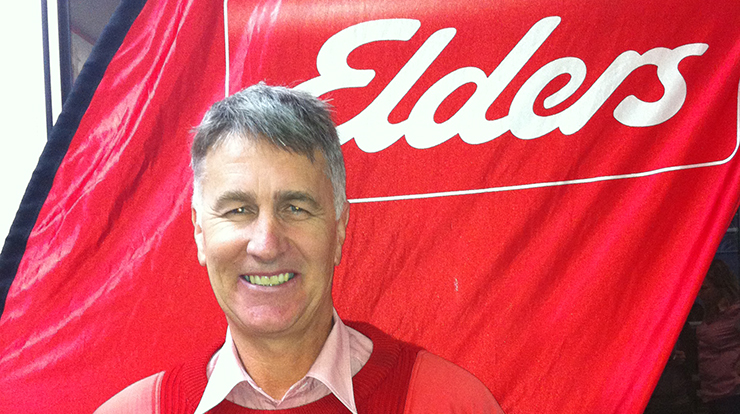Improving performance with effective weaning
19 March 2024
 Rob Inglis, Elders Livestock Production Coordinator.
Rob Inglis, Elders Livestock Production Coordinator.
On-farm strategies which ensure weaners are well-prepared to thrive in backgrounding or feedlot operations also deliver the added benefit of meeting the expectations of consumers.
Elders’ Feeder Ready Program – the only audited weaning program in Australia – supports producers to set their weaned cattle on the path to productivity.
Rob Inglis, Elders Livestock Production Coordinator, said with the red meat supply chain increasingly under the microscope, the program supported industry to demonstrate its credentials as stewards of best practice in animal welfare.
“It shows that we can produce healthy, appropriately prepared cattle which are certified ready for feedlots or backgrounding – and command a premium price as a result,” Rob said.
Set feeders up for success
Animals which are accredited through the Elders Feeder Ready Program receive an Elders’ pink ear tag which immediately identifies them as having been weaned in-line with industry best practice.
The program has two mandatory criteria:
- audit by a third-party expert
- a vaccine schedule.
In addition, there are three recommended steps designed to help optimise performance:
- a trace mineral injection
- an internal and external parasite treatment program
- a good quality ration.
Third-party audit
Rob is one of three independent auditors conducting site visits to inspect the cattle post-weaning and ensure they meet each of the program criteria. This includes observing cattle behaviour in the yards to confirm they have been yard-weaned for at least seven days.
Vaccine schedule
Feeder Ready complements the Vaccine Ready Guidelines, with the independent auditors confirming Clostridial and Bovine Respiratory Disease vaccinations have been given and that any additional vaccinations are also noted on the schedule.
Other strategies
The program also recommends animals receive a trace mineral injection (Multimin Evolution), appropriate parasite treatments, and a good quality ration to support their accreditation. Rob said these recommendations were assessed by auditors on a case-by-case basis.
“We look at the circumstances of each property to determine what parasite treatments or rations are most appropriate,” he said.
“The important thing is we’re delivering transparency around these criteria so that buyers receive a full account of how that animal has been treated up to the point of sale.”
Benefits of the program
There are a range of benefits from accreditation through the program.
Price premiums: The Elders pink tags make it easy for buyers to identify feeders that have been correctly weaned, potentially delivering price premiums to producers.
“At the bigger yardings where feedlots are competing for stock, we expect to see premiums of $0.30/kg for weaned cattle, but there’s been plenty of instances where we’ve seen $0.20/kg premiums,” Rob said.
Transport ready: Effective weaning makes cattle easier to handle in the yards and calmer during travel, creating a safer environment for both animals and humans.
“For transporters, appropriately weaned cattle are easier and safer to load and unload,” Rob said.
“They’ll also experience far less stress during trips and be in better condition when they eventually reach the feedlot.”
Improved performance: Cattle which have been appropriately weaned convert feed more efficiently and spend less time in feedlots, resulting in lower feed costs and reduced carbon emissions.
Improved survival: More importantly from the feedlot’s point of view, appropriately weaned cattle have a lower morbidity rate.
“We have stats from a couple of feedlots which show the morbidity rate for unweaned cattle is around 20%, while for properly weaned animals it's around 4%,” Rob said.
“That’s a significant difference and I think we're now seeing more feedlots walk past cattle that haven’t been properly weaned because they just don't want to run that risk.”
Get Feeder Ready
Joining the Elders Feeder Ready Program is easy.
You don’t need to be an Elders client, simply contact your Elders Livestock branch for details.
Weaning strategies
Once calves are 160–200kg, Rob suggests vaccinating them and then letting them back in with the cows for at least three or four imprint feeds of whatever ration they’ll be weaned onto.
“By vaccinating early and allowing them to adjust to the new feed, the only stress will be separation from the cow,” he said. “They may be upset for a few hours, but once they discover the feed and start eating it’s a pretty smooth transition.”
Rob also suggests drafting by weight, rather than sex.
“By separating them into a heavy group (>200kg), a middle group (175–200kg) and a lighter group (<175kg), the hierarchical effect is reduced and there’ll be less bullying.
“In a perfect world, the diet would be modified according to size,” he said.
“The lighter weaners would be fed a better ration to help them catch up to the bigger animals, with the ultimate goal being to have them all reach a similar weight within two to three months.”


